There are a number of female torso figures found in the Rhondda Wales.
Thought to be fairly modern in origin they are still an odd find.
Wales and the Marches
Saintbury
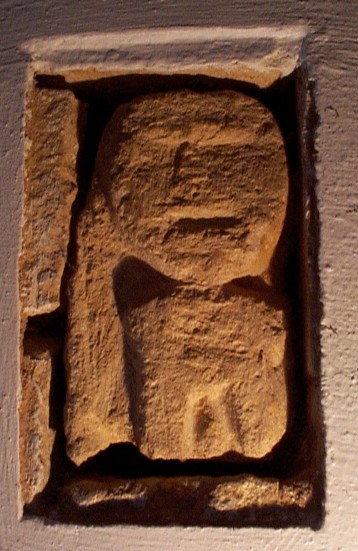
The Figure
This figure was reported to us by a local of Saintbury Gloucester as a Sheela na gig. From initial photographs it seemed promising as there appeared to be a cleft between the legs but when we visited the site this proved to be a trick of the light. Nonetheless the figure is obviously very old and does have certain sheela type characteristics such as the large head.
Location
Tugford
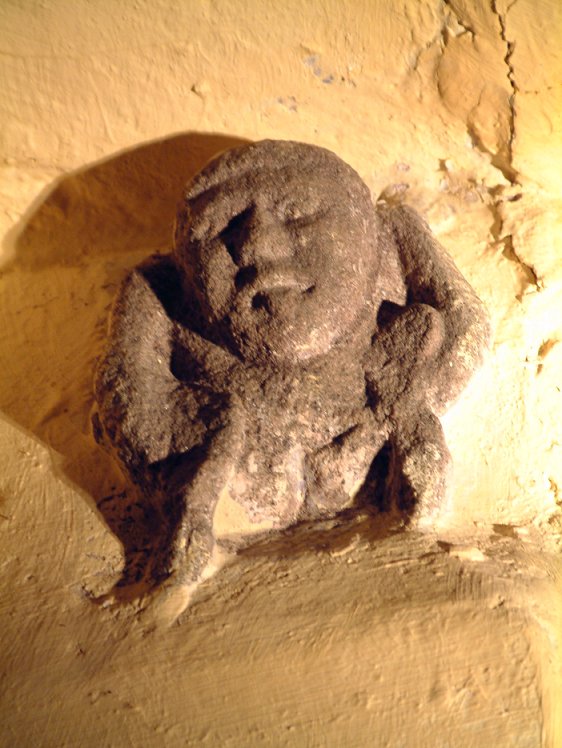
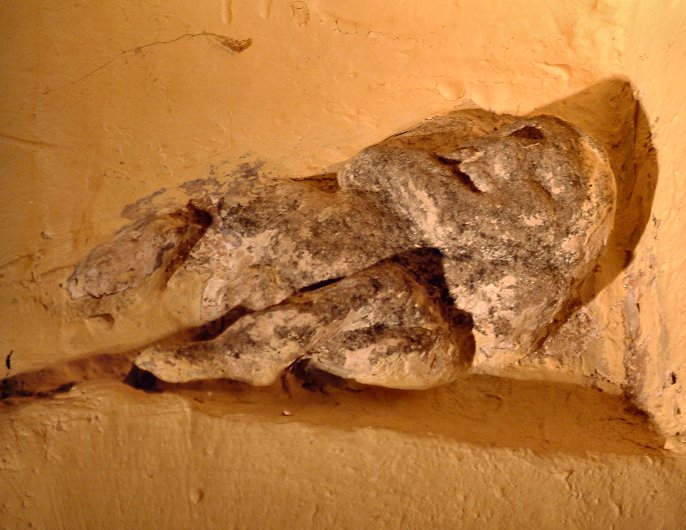
The Figures
Location: ///officer.array.ruin
These two figures can be found inside St Catherines church Tugford either side of the main door. The sheela on the right is in a better state than the one on the left. It bears a passing familiarity to the Sheela at Kilpeck.
The right sheela (see right) is squatting in an upright position it’s tongue protrudes and both hands are gesturing to the vagina. The right arm is beneath the right knee while the left arm appears to be in front of the left leg. Due to damage on the figure this hard to make out there also appears to be damage to the left knee.
The one on the left is recumbent (see below), lying on it’s left side. The left sheela is badly weathered and it is difficult to make out details on the carving. This figure has always been referred to as a sheela but it is very hard to make out any details from the photograph on the right there appears to be faint facial features and the figure appears to be hugging something with it’s left shoulder hunched up against the left cheek. Its very hard to determine any features on this figure let alone a definitive sex so the sheela epithet may not be justified.
Both of the sheelas are above head height on wall making close examination difficult.
The Tugford, Holdgate and Church Stretton Sheelas are all in the same vicinity. Holdgate and Tugford being a mile distant from each while Church Stretton is about 10 miles away. The Diddlebury figures are approximately 2 miles away.
There is more information on the Shropshire group of sheelas at the Shropshire Promotions website
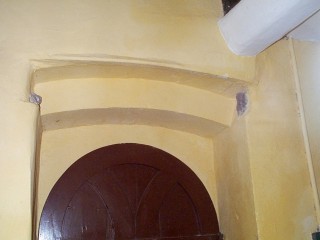
Location
Raglan – The Carving
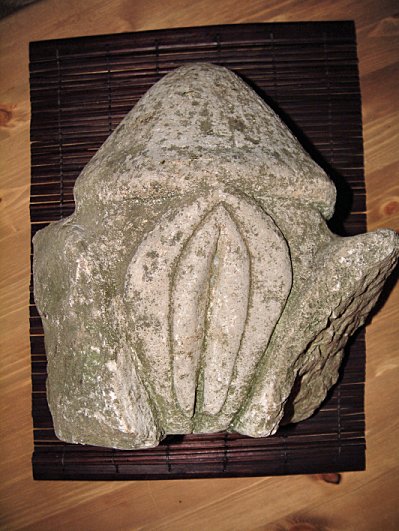
The Figure
Mr. Martin Stevens found this carving in the garden of his house. It combines both male and female organs in the same carving. I’ve not seen anything else like this but would be happy to hear from anyone who knows of a similar figure. Unfortunately there is absolutely no indication of how old the figure is or where it originated. No other remains were found in the garden and while the building is old it there is no history that would give any clue to it’s origin. Mr Stevens has taken it to various museums and while they have expressed a mild interest there has not been much information forthcoming. When Mr Stevens found the carving it was fairly clean the patination you see is a result of it being stored in his garage.
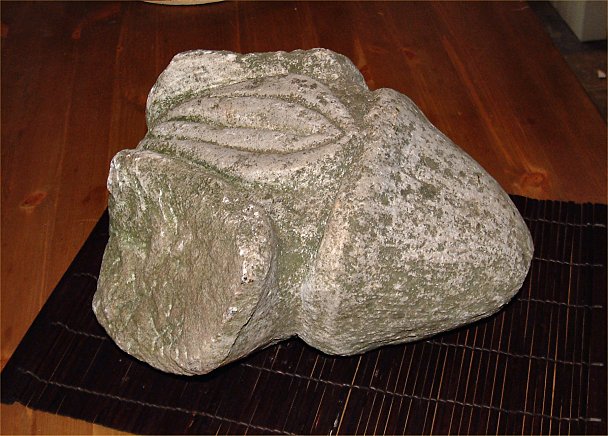
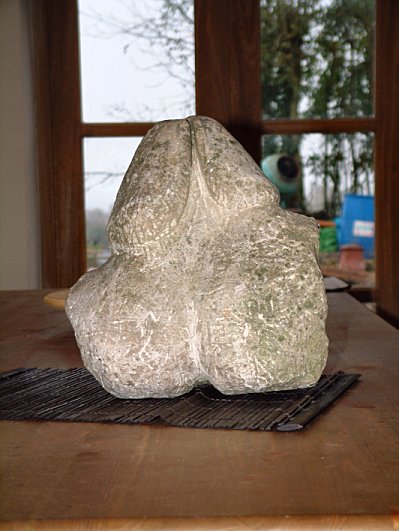
Location
This figure is in private possession and is not viewable.
Raglan Castle
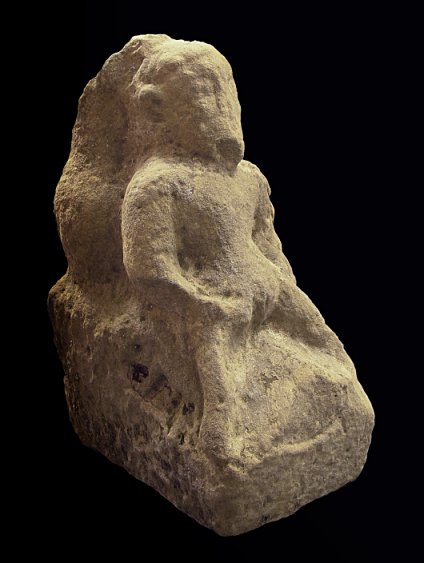
The Figure
In her recently published book, Sheela-na-gigs Unravelling an Enigma Dr Barbara Freitag gave details of a Sheela na Gig located in Raglan Castle. Although exhibitionist figures are frequently located on secular buildings in Ireland (mostly castles), this is the forth known case on the British mainland. The other figures being Haddon Hall, Tickhill and the recently discovered figure at Donyatt in Somerset (although it’s thought that this figure originated from a chapel).
Raglan Castle, Monmouthshire is considered one of the county’s most magnificent late medieval castles. Constructed on the site of an 1100 motte and bailey castle with timber buildings, the present structure was commenced in 1432. Further additions were made up until 1549. The castle was abandoned on 17 August 1646 following the siege during the Civil War, and is now an atmospheric ruin. The castle is now maintained by CADW.
The Raglan figure, is a waterspout with a channel running down the back in pretty much the same manner as the Margam figure. It has pointed ears and is very worn. The figure has a potbelly, and below there is a shadow between the legs where you would expect to find a vulval cleft. The figure does gesture towards the groin is with the right hand. The right arm is for most part missing. What does remain seems to indicate that this hand is also gesturing towards the groin however the thigh on the left seems to join the body as you would expect so the left hand may have been further back than the right. You could take this as a pointer to the figure being exhibitionist i.e. pointing to the genitals.
The original location of this figure is not known, but a photograph dating from 1860 puts it at the foot of the Grand Stair in the Fountain Court part of the castle. This area of the castle dates from 1460 – 1469. Later it was found among other fragments in the castle grounds. The figure is currently being restored by CADW. Eventually the figure will be put back on display in Raglan Castle.
Richard Avent the Chief Inspector of Ancient Monuments concludes:
‘However, if a gargoyle, it is in a rather different style from the only other gargoyles at the castle which are at the top of the main Gatehouse and Closet Tower. All in all, the exact origins of this sheela are a bit of a puzzle but it must, presumably, be linked in some way to either the 15th century castle or perhaps something which preceded it on the same site.’
Is this a sheela na gig?
Most female exhibitionist figures in the U.K. tend to originate in the 12th and early 13th centuries. By the 15thC figures had become more monstrous and male exhibitionist figures such as bottom showers are more common. Female exhibitionists are few and far between and those that do exist seem to be a lot more modest than their 12thC counterparts. (Another example is the Stoke Sub Hamdon 15thC exhibitionist figure.). There is a question mark over whether this figure was once exhibitionist at all. While it does have a faint suggestion of a vulva it lacks the overt and shocking exhibitionism of earlier figures such asKilpeck and Oaksey. It seems with 15thC figures we are moving towards a “nude” type representation rather than “sheela-na-gig” type exhibitionism. This taken in account with the height at which the figure was likely to reside would seem to indicate that later figures , if indeed they are connected to the earlier shocking “sheela-na-gig” motif they are becoming more modest in their execution.
Our thanks to Sian Rees and the late Richard Avent of CADW for allowing us to photograph this and the Haverfordwest figure and for allowing us to publish these figures on the website.
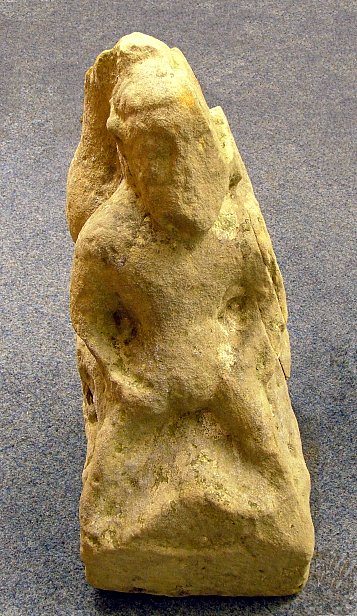
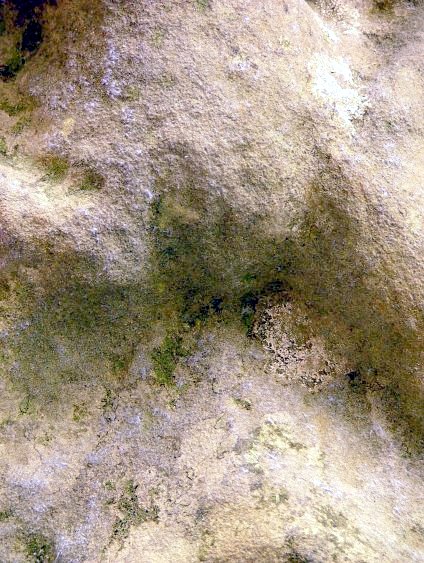
Location
Cleobury Mortimer
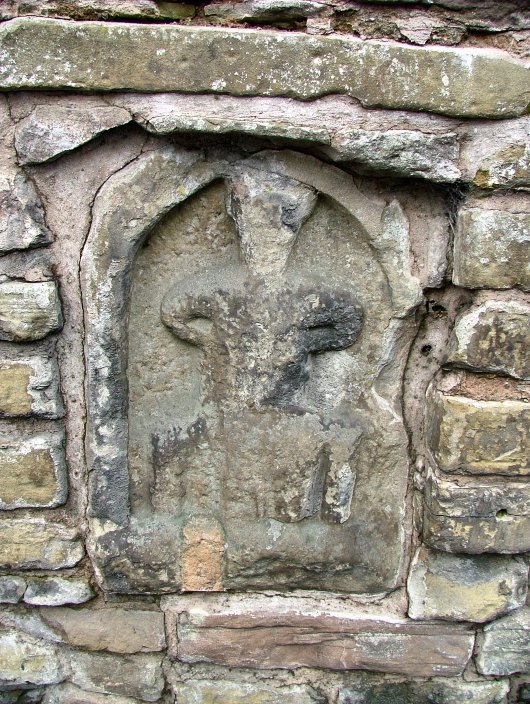
The Figure
Location: ///bundles.fetching.locating
The small town of Cleobury (Pronounced Clibbery) Mortimer lies in Shropshire. Set in the retaining wall of the churchyard of St Mary’s there is very worn carving of what appears to be a seated figure with bent arms. As you can see from the photograph below the figure faces directly onto the main road through Cleobury. This figure has been defined as a Sheela Na Gig by the Courtauld Institute of Art . There is a record of the figure on the internet here on the institute’s “Public Monuments and Sculpture” pages. After speaking to Dr. M.W.Baldwin of Cleobury’s history society he informed me that the definition of the carving as a sheela na gig was a tentative one. After having seen the figure it is very hard to say what it originally represented as it is too worn to be able to identify any features. There does appear to be a cleft at the bottom of the carving, but it’s hard to distinguish any legs. There also appear to be two pillars either side of the figure. The pillars may be legs which would make the figure splay legged or equally they could be part of something the figure is seated on. Dr Baldwin also mentioned that the figure is fairly near Church Stretton which would make the figure part of the Shropshire sheela na gig cluster. The church is of the right age being from the late Norman period according to some information in the church. There is also a font or tub set into the wall of the porch which was found in a local garden. The church is also famous for it’s twisted spire.
The position of the arms seems to count against this figure being a sheela as they appear to b holding something over the abdomen/chest. This may indicate that the figure is very worn representation of Christ holding a bible. These Christ figures tend to be seated as well. All in all this figure is really too worn to make a hard and fast judgement as to whether it is a sheela na gig or not although some of the features suggest otherwise.
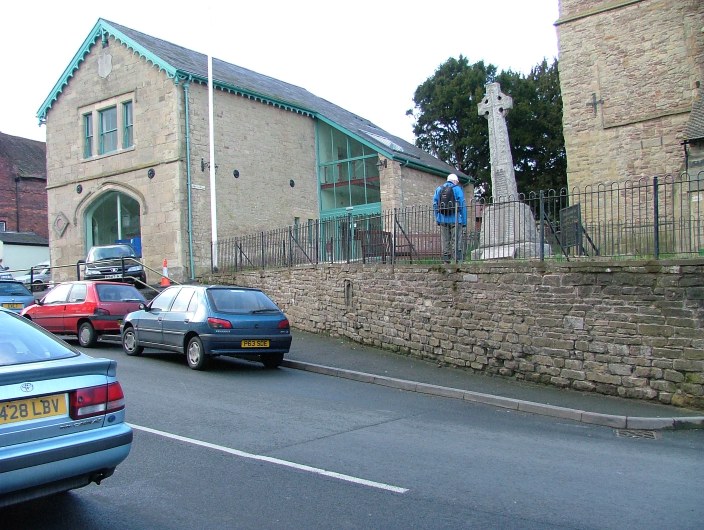
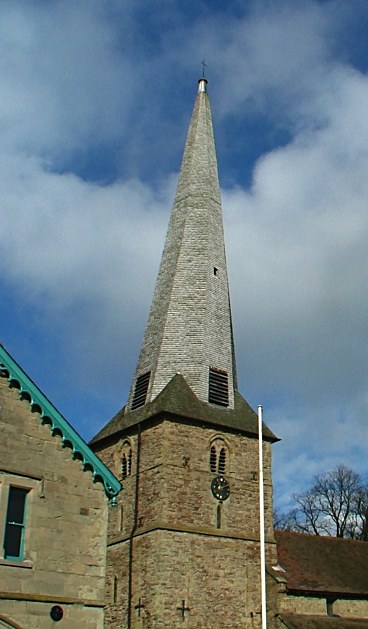
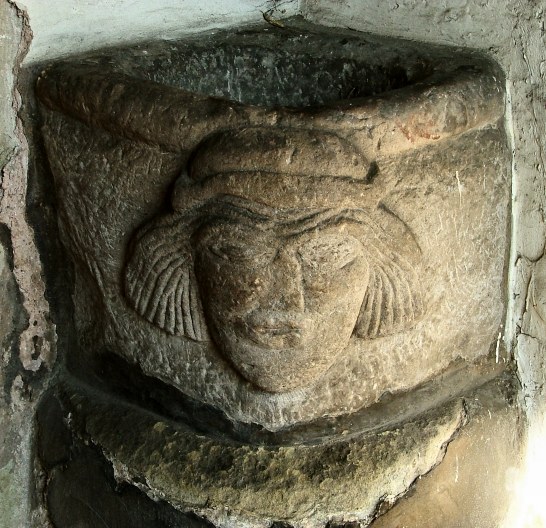
Location
Elkstone
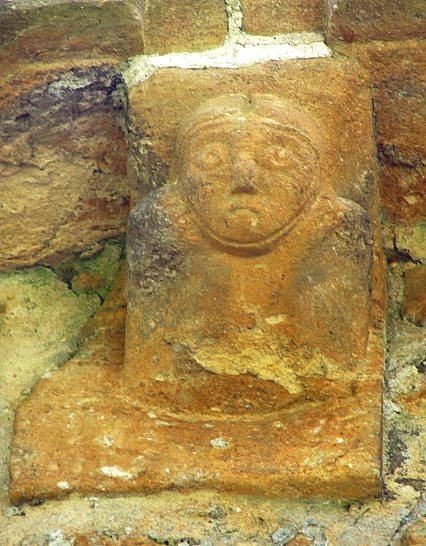
Updated 2004-08-28
Elkstone is a richly carved parish church which is in the centre of a cluster of ancient churches in the Cotswolds.
This carving (right) is mentioned in Images of Lust by James Jerman as being a damaged carving very similar in appearance to the Kilpeck sheela. I think from the picture above you will agree that there is a passing similarity but no more than that. The execution of the carving is less defined than the Kilpeck sheela and the figure has a head of hair or some sort of head dress. Another point to notice is that figure looks quite morose unlike the happy grin of the Kilpeckcarving.
The figure does not appear to be damaged apart from the obvious curving cut on the left and slight rough patch at the bottom of the figure. It has been described by James Jerman as being the Kilpeck sheela with the bottom half chopped away. This does not seem to be the case. The underside of the figure is quite smooth the paler discolouration you can see is not big enough to indicate the removal of a large part of the carving. The figure seems to be a head, shoulders and torso protruding from the wall. I have to admit I don’t quite understand why this figure has been classified as a possible sheela at all. At first I thought there might have been another candidate for an exhibitionist figure which appears to be lifting its skirts. However the figure itself is very confusing (see photo below). Having now seen other musician figures its more likely that this figure is a rote or Harp player as the composition of the figure fits in with other less worn musician figures.
The church has obvious connections to the Herefordshire school of sculpture. The heads at the top of the rib vaulting are very similar to those found at Kilpeck. The corbels on the church are Romanesque in style and probably originate from the 12thC. There are many motifs on the corbels including astrological, animal and abstract figures. There are also some later (15thC?) gargoyles on the tower. The tower also sports some well preserved minstrel figures on it’s corners. One plays a shawm while another plays a wind instrument of some type. There are many fine carvings on the church including a fine tympanum. It’s well worth a visit if you are in the the area.
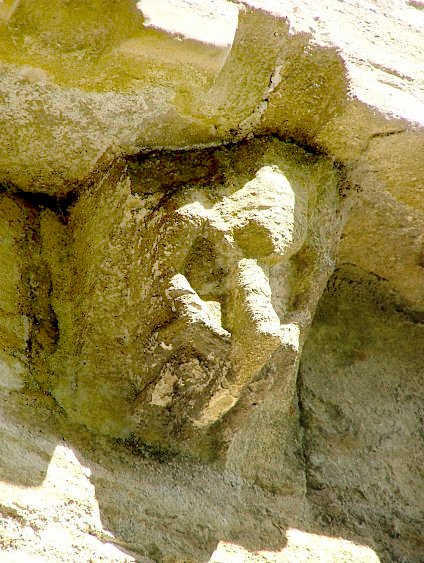
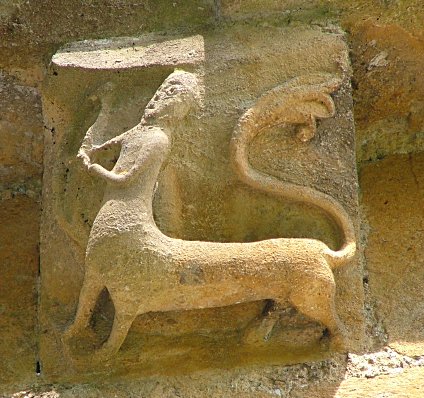
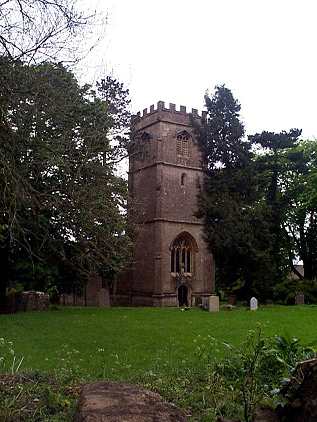
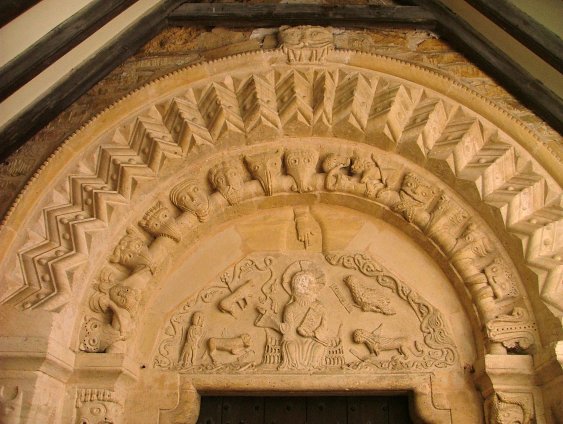
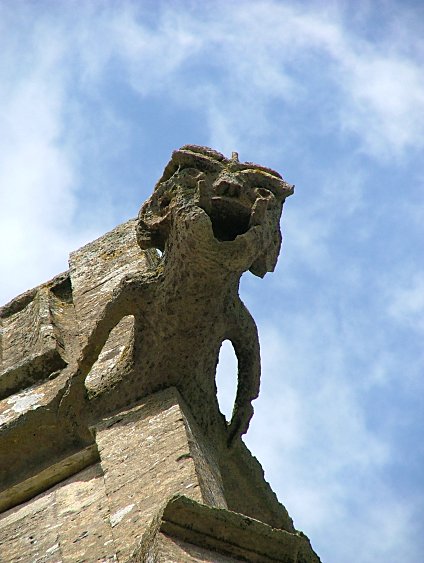
Location
Lower Swell
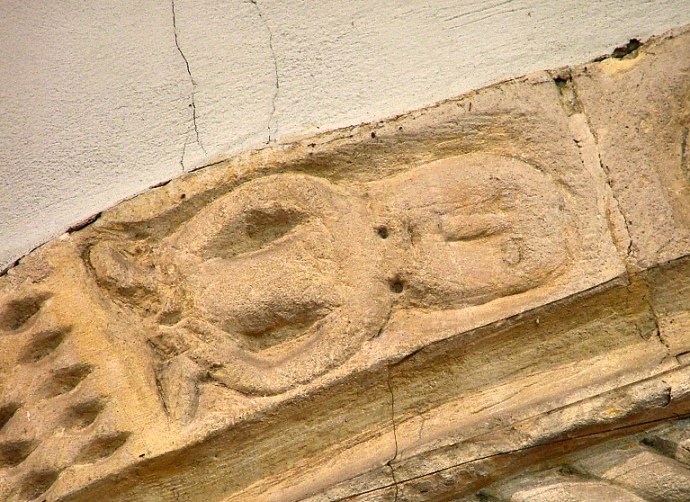
The Figures
The church of St Mary’s at Lower Swell in the Cotswolds contains a fine norman archway which holds a crude Sheela Na Gig and and a possible exhibitionist male.
The figure is to be found on the left side of the arch. The figure has a large head and left hand points to a small but definite cavity between the legs (see right). There are many other carvings including a hare and what appears to be a man battling with snakes. In addition to the sheela on the arch there also appears to be an exhibitionist male figure on a pillar on the left of the arch (below). The figure does not have clearly defined genitals but there does seem to be some suggestion of something there as you can see. This is another example of the difference in degree of exhibitionism seen in Romanesque carvings. While this figure lacks the overt exhibitionism of say Kilpeck it nevertheless has had a small vulva carved and even seems to be indicating to it in much the same way as the Oaksey example.
The male figure also seems to have inscribed ribs, a feature normally though not exclusively ascribed to sheelas. The pillar opposite the male figure shows some sign of defacing or is unfinished so there is a possibility that another figure originally faced the male figure. (See right).
The church itself is quite small but boasts some rich carving. There are corbel heads on the outside of the church which are very reminiscent of Kilpeck. The connection to Herefordshire carvings is further borne out by the tympanum above the front door which depicts a tree motif, usually referred to as “The Tree of Life”. Tympana bearing trees are a feature of the Dymock School in South Herefordshire. However the tree is not a particularly well carved specimen unlike the Herefordshire and Dymock examples. In addition to the tree a bird is depicted eating the tree’s single fruit. In his book “The Herefordshire School of Romanesque Scupture” Malcom Thurlbury suggests an origin for this tree motif from the medieval “Bestiary” which he cites as an often used source for church sculpture.
“The perindens is a tree found in India; the fruit of this tree is very sweet and pleasant, and doves delight in its fruit and live in the tree, feeding on it. The dragon, which is the enemy of doves, fears the tree because of it’s shade in which the doves rest and it can approach neither tree nor shadow.”1 The Bestiary then goes on to give a religious interpretation of the various symbols in the passage and how they relate to Christian practice. As we can see from the above quote it is obvious that the sculptor took his inspiration from the above passage. In addition to the tree motif the tympanum is also bordered by a repeated X cross pattern which also associated with other churches of Marches2
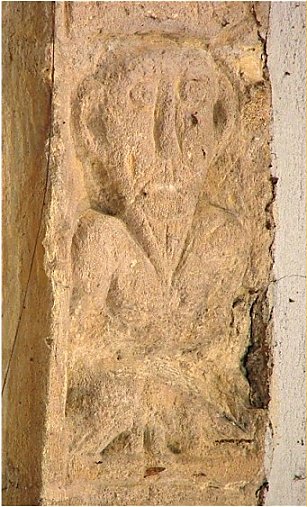
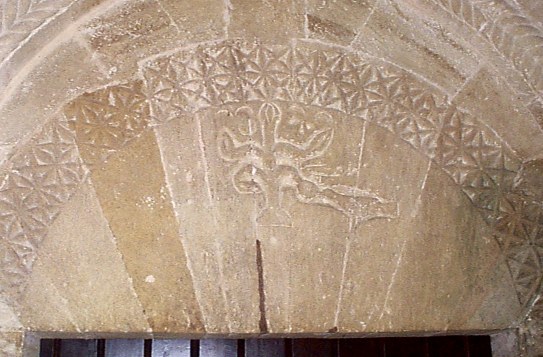
Location
Ampney St Peter
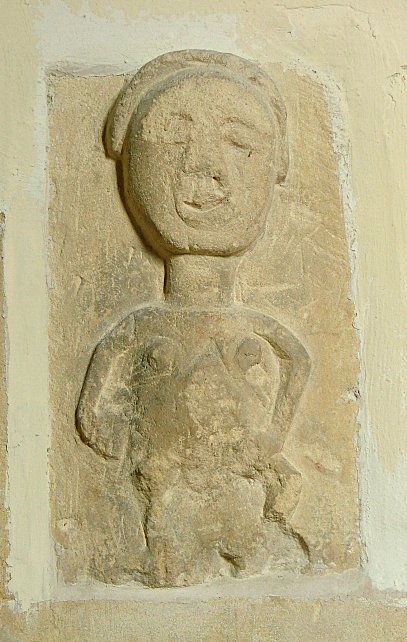
The Church
This sheela can be found in the village church of the picturesque village of Ampney St Peter near Cirencester, Gloucestershire. The church has a late Saxon nave with rounded plain doorway adjacent to the main door. The church has been much modified with a major extension on the south side of the church being added in 1878-79. The north side however is original and still has a single gaping mouth carving just below the roof. The tower looks very old (see below) and appears to be Saxon but I cannot find information to confirm this. There appear to be two re-used gravestones in the tower windows.
The Sheela na gig
It is situated inside the church to about 7 ft off the ground to the right of the side door (see below). The genital area has been defaced at some point, however you can still see the faint outline of the vulva and slit between the legs. The figure gestures towards the groin with both hands. The rest of the figure is fairly well preserved with high small breasts and an over large head sporting a smile. The legs and arms are spindly. It’s worth noting that even though the figure is unlike the Kilpeck sheela it also smiles in a similar manner. The figure is also unusual in that it appears to have a headdress or “hair”. Jack Roberts in the Divine Hag of the Christian Celtsmentions that this figure has been “brought inside” but does not say where the figure was originally located.1
N.B. The first time I visited the church it was locked but the second time the church was open. I believe a key is available from one of the nearby houses if you do find it locked.
John Harding
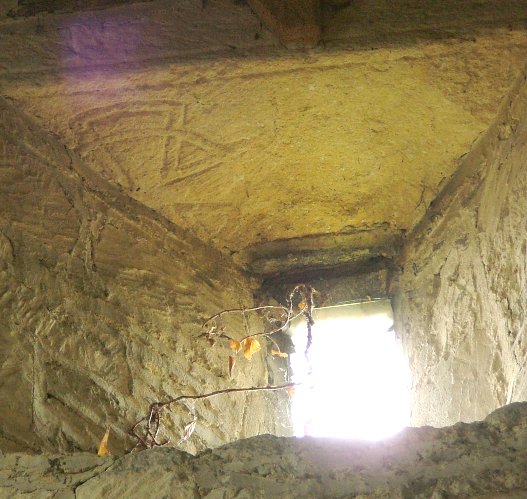
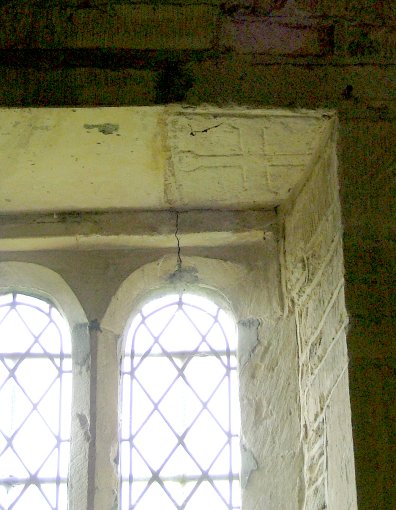
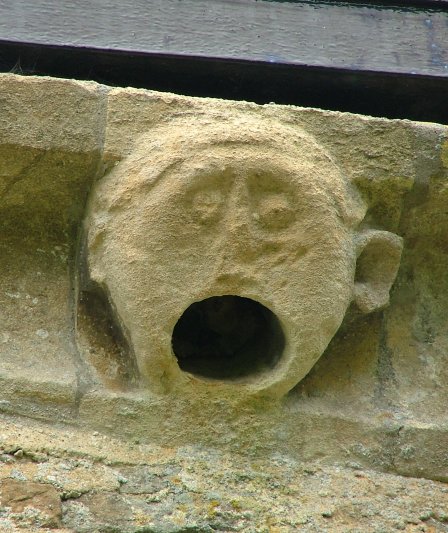
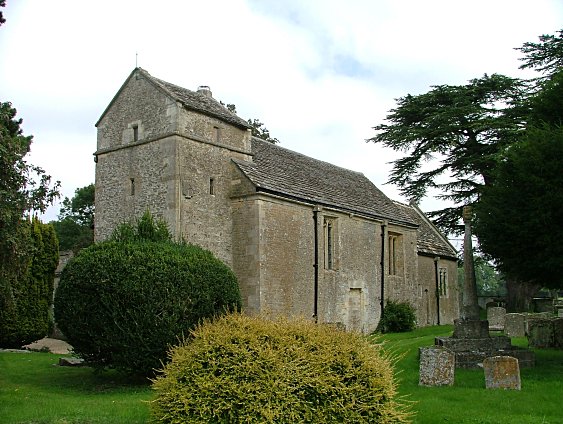
Location
Oaksey
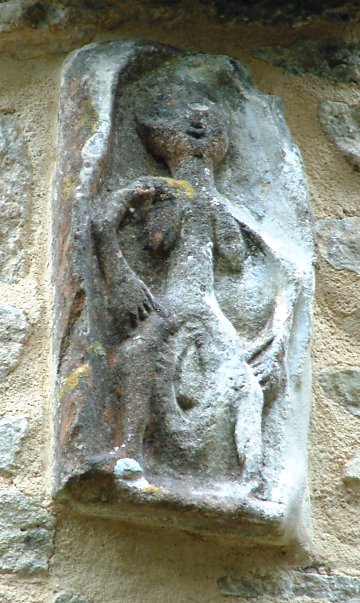
The Oaksey Sheela Na Gig
The small village of Oaksey lies in Wiltshire some 8 miles South West of Cirencester. It is called Wochesie in the Domesday book but is also called Occhesei and Wokesey ,Woxy and Wrockeseye
This sheela can be found on the north wall of the Parish Church of Oaksey Wiltshire. On my first visit to the church my camera decided to lose most of the pictures (The curse of the sheelas strikes again?). The sheela can been seen just to right of the window about half way up.The Oaksey Sheela Na Gig
This sheela is quite shocking in the explicit and exaggerated carving of the vagina even including the clitoral hood. The vagina as you can see from the photograph is incredibly exaggerated. Half of the head has broken off yet the rest of the carving is in pretty good condition. Inside the church there are a number of medieval wall paintings .There is an Irish story, “Da Derga’s Hostel” where a hag’s pudenda hangs to her knees. This could almost be a description of this carving. The figures right hand rests on the the thigh and it looks like a finger points to the exposed vulva. This pointing motif can be found in other figures including Lower Swell and the now destroyed Buncton figure.
I recently revisited the church to find that some efforts have been made to conserve the carving by placing a lead roof above it (left). It looks like some effort has been made to clean the carving and the surrounding masonry has been re-pointed. It’s interesting to note that the carving is being looked after even in our modern times and is obviously held in some respect or at least is considered to be worth saving.
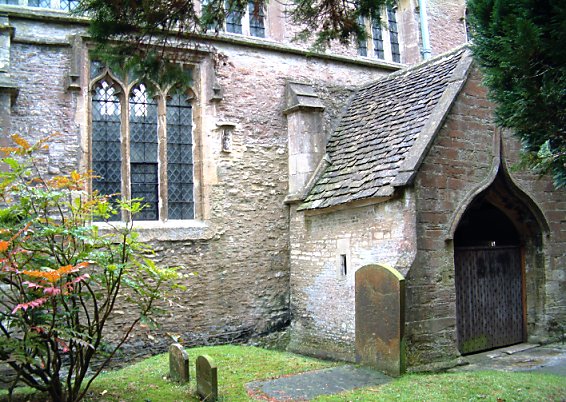
A Romanesque connection
No mention is made of a church in the Domesday book and the current church, dedicated to all saints, is thought to go back to the middle of the 13th century. Its architecture contains elements of the early English and Perpendicular styles. The sheela na gig motif however seems to originate from the 12th century especially those with exaggerated genitals like the Oaksey example. So does this make the sheela a later example of the motif? There is some tantalising evidence that suggests an earlier Norman or Romanesque phase of the church which is now less evident,John Britton in his “Topographical Sketches of North Wiltshire” in 1826, wrote that the nave and chancel were separated by a massive semi-circular arch. Given that the Early English period (the period directly following the Romanesque) is distinguished by its pointed rather than round arches, the existence of the round arch would seem to indicate an earlier Romanesque incarnation of the church. It would be interesting to see if any other evidence of this incarnation is still present in the church. Further evidence for Norman activity in the village lies in the remains of Norwood Castle, a motte and bailey construction to the North West of the church. In 1870-72, John Marius Wilson’s Imperial Gazetteer of England and Wales wrote the following “The church is partly Norman; was recently restored; has some stained windows, and an embattled tower”. This seems indicate that the round arch fell victim to Victorian “improvement” and was possibly replaced some time before 1872 with the current Victorian Gothic arch that we see today. Given that the round arch points to an older Romanesque phase of the church, then it would make more sense to attribute the sheela to that period rather than the later ones. If this is the case then it seems that the figure was regarded as worth saving and including in the modifications made to the church down the years.
Gallipot Eyes
The figure is briefly mentioned in the book Gallipot Eyes by The Flame Trees of Thika author Elspeth Huxley who lived in the village for a number of years. Bizarrely the figure is referred to as male!